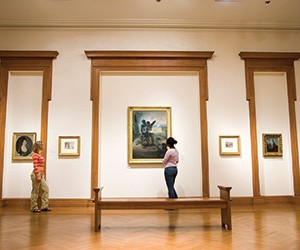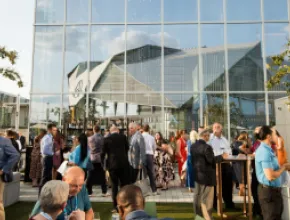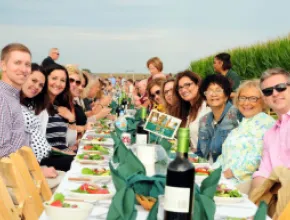Hampton Roads witnessed land and sea battles of the American Revolution, the War of 1812 and the Civil War. The prolific shipyards of Newport News launched mighty warships throughout the first and second World Wars. Naval Station Norfolk is still the world’s largest naval base, home to the lion’s share of the American fleet of carriers, destroyers and submarines, as well as aircraft.
In more peaceful times, Hampton Roads was also a cradle for progress. It fostered the second college, the first African-American community and the first free public schools in the country.
There are plenty of unique ways for groups to experience the region’s rich past.
Virginia Beach
Cape Henry was the original landing site of the Virginia Company, led by Christopher Newport. The group went on to settle Jamestown, the first enduring settlement of English colonists.
“Virginia Beach is full of rich history,” says Al Hutchinson, vice president of convention sales and marketing for the Virginia Beach CVB. “Visitors are guaranteed a remarkable experience exploring our historical homes, monuments, museums and landmarks.”
First Landing State Park, listed in the National Register of Historic Places, commemorates the spot where the Virginia Company made land. The 2,888-acre park is located along 1.5 miles of Chesapeake Bay shoreline. It offers a 300-seat amphitheater, a picnic shelter capable of welcoming 80 and a 60-person meeting room in its Trail Center.
The Military Aviation Museum lovingly preserves one of the largest private collections of World War I and World War II military planes in existence. Its 15,000-square-foot World War I hangar is available for rentals, and historic aircraft can be hired to perform during events.
Built in 1927, the Cavalier Hotel has hosted seven presidents so far. Part of an 18-acre oceanfront property, the Cavalier offers a total of 400 guest rooms and event facilities large enough for groups of 2,000. PageBreak
Norfolk
Founded in 1682, Norfolk was destroyed by shelling from English ships during the American Revolution. In 1862, naval history was made off the northwest shore of the city during the Battle of Hampton Roads. The fight was the first between two ironclad ships, the CSS Virginia and the USS Monitor.
The Tazewell Hotel & Suites opened in 1906 as part of the city’s triennial celebration of the founding of Jamestown. The 58-room property offers meeting space for 60.
Nauticus, a maritime museum, comprises historical treasures including the World War II era Battleship Wisconsin, the Hampton Roads Naval Museum and an exhibit exploring the resting site of the USS Monitor. Full-facility rentals can accommodate groups as large as 2,000.
Groups can tour Naval Station Norfolk with Tidewater Tours Inc. Guided tours are an opportunity to see aircraft carriers, destroyers and amphibious assault vessels, as well as many historic homes in the area.
Hampton
“Hampton is rich in American history, particularly in African-American and Civil War history,” says Sallie Grant-DiVenuti, executive director of the Hampton CVB.
The first Africans arrived in the English North American colonies in 1619 where Fort Monroe is now. During the Civil War, the Union-held Fort began dubbing escaped slaves “contraband of war.” The freed people built the Grand Contraband Camp, the first African-American community, in what is now downtown Hampton.
President Obama declared Fort Monroe a National Monument in 2011. Guided tours of the Casemate Museum, where Jefferson Davis and other Confederates were imprisoned, are available for groups of 10 or more. The Hampton CVB offers a geocache adventure in Fort Monroe accessible via smartphone from its website.
Hampton University was founded in 1868 to educate freedmen and Native Americans. McGrew Towers Conference Center, situated on the Hampton River, is available for rental year-round. It can welcome groups as large as 350. Hampton University Museum is available to host receptions.
The Hampton CVB recently launched a 30-page guide to the city’s African-American history. PageBreak
Williamsburg
Williamsburg has a history of prestigious meetings—some more violent than others.
“We can’t forget those meetings held with Thomas Jefferson, George Washington and Patrick Henry debating the ideas of liberty, independence and personal freedom that led to the founding of American democracy,” says Bob Harris, senior vice president, tourism at the Greater Williamsburg Chamber and Tourism Alliance. “And how about that ‘meeting’ between generals Washington and Cornwallis on the battlefield at Yorktown in 1781? It seems safe to say that meetings here have been known to change ‘the course of human events.’”
Jamestown, Yorktown and Williamsburg form the Historic Triangle, an area with great significance to American history, specifically the events leading up to the Revolutionary War. The three communities are joined by the scenic Colonial Parkway and offer many opportunities for historical group outings.
Costumed guides and outdoor exhibits bring colonial life and the American Revolution to life at Jamestown Settlement and the Yorktown Victory Center. Jamestown Settlement can welcome 700 for full facility rentals, while Yorktown Victory Center can host 300.
Founded in 1693, the College of William & Mary was the second college founded in the American colonies. Its Sadler Center can welcome groups as large as 800.
Newport News
A small town surrounded by plantations until after the Civil War, Newport News became a world shipbuilding capital in the late 19th century.
“During its history, Newport News has been not only a harbor for troops, but ships as well,” says Cindy Brouillard, director of tourism at the Newport News Tourism Development Office. “Beginning in 1896, Newport News Shipbuilding began building the first of many battleships. During one remarkable 30-month period in World War II, the yard built eight aircraft carriers.”
In spring 2012, the U.S. Army Transportation Museum at Fort Eustis converted its auditorium to a Regimental Room. The room can welcome as many as 100. The museum, which is also planning a 45,000-square-foot expansion, houses vehicles, insignia and artifacts relating to American military transport history from the Revolutionary War to the present day.
The Mariners’ Museum takes groups through seafaring history with 35,000 maritime artifacts. Its USS Monitor Center allows visitors to relive the Battle of Hampton Roads. The museum can host groups as large as 600.
The Virginia War Museum traces American military history from 1775 to the present day. Group tours are available.
Several historic mansions are also available for group tours and receptions, including Newsome House Museum and Cultural Center, Endview Plantation and Lee Hall Mansion. PageBreak
Chesapeake
The site of a great victory for the revolutionaries during the War for Independence, Chesapeake was officially designated a city in 1963.
“Chesapeake is home to the Battle of Great Bridge, which was a turning point in the Revolutionary War,” says Kim Murden, tourism manager at the Chesapeake CVB. “The new Battlefield Historic Park offers a walking tour and interpretive signage regarding this historic event.”
The 112,000-acre Great Dismal Swamp National Wildlife Refuge is located partially in Chesapeake. The swamp was home to a community of escaped slaves as early as the late 17th or early 18th centuries, and it sheltered many more enslaved people as they journeyed north along the Underground Railroad. Groups can charter kayak tours or historic 15-person war canoes to travel along the canal and experience Chesapeake’s history up close.
Portsmouth
Portsmouth has been home to what is now the Norfolk Naval Shipyard since 1767.
Groups can take the self-guided “Path of History” tour around Portsmouth’s Olde Towne Historic District. Landmarks include the Norfolk Naval Shipyard, the Naval Medical Center Portsmouth and a large collection of antique homes.
Located in the heart of Portsmouth’s historic downtown, the Governor Dinwiddie Hotel & Suites opened in 1945 and may have sheltered President Truman when he visited the shipyard. There is a 1,900-square-foot ballroom and a smaller space suitable for 20.
Suffolk
Suffolk was torched by English forces during the Revolutionary War and held by the Union during the Civil War.
The Historic Obici House at Sleepy Hole Golf Course was built in the 1920s for the founder of Planter’s Peanuts. It welcomes receptions and banquets.
Suffolk Division of Tourism conducts a number of historical tours by bus, on foot or in canoes. Guided tours include a Great Dismal Swamp walking tour and a downtown ghost tour.
Frequent contributor Kelly Crumrin enjoys exploring Virginia’s historical sites on family vacations.






